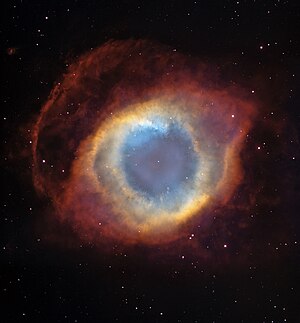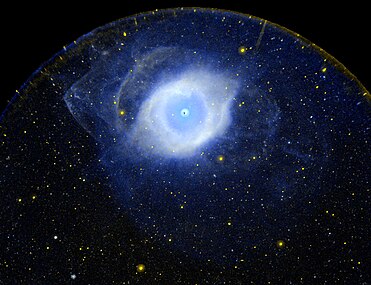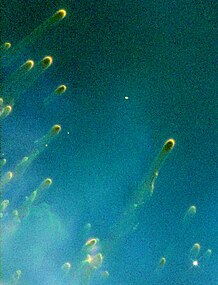Helix Nebula
|
Planetary Nebula Data of the Helix Nebula |
|
|---|---|

|
|
| Superimposed image of the Hubble Space Telescope and the 4 m telescope of the Cerro Tololo Inter-American Observatory | |
| AladinLite | |
| Constellation | Aquarius |
|
Position equinox : J2000.0 |
|
| Right ascension | 22h 29m 38.55s |
| declination | -20 ° 50 ′ 13.6 ″ |
| Appearance | |
| Apparent brightness (visual) | +7.3 mag |
| Apparent brightness (B-band) | +7.5 mag |
| Angular expansion | 16 ′ × 28 ′ |
| Central star | |
| Physical data | |
| Redshift | (-50 ± 33) · 10 −6 |
| Radial velocity | (-15 ± 10) km / s |
| distance | 650 ly |
| history | |
| discovery | Karl Ludwig Harding |
| Date of discovery | September 1823 |
| Catalog names | |
| NGC 7293 • PK 36-57.1 • ESO 602-PN22 • GC 4795 • BD -21 6239 | |
The Helix Nebula (also NGC 7293 or Eye of God ) is a planetary nebula in the constellation Aquarius with a brightness of 6.30 mag and an apparent diameter of 16 '× 28'. It was discovered in 1823 by the German astronomer Karl Ludwig Harding .
The Helix Nebula is the closest planetary nebula at a distance of about 650 light years and thus the one with the largest apparent diameter. Therefore, details of the gas structure can also be resolved in its envelope.
With the Hubble telescope in 1996 it was even possible for the first time to record nodes in the shell that were previously unknown and allowed new conclusions to be drawn about the formation of planetary nebulae. But they also raised new questions. It is not clear whether the nodal germs arose during the ejection of the shell or whether they originate from activity of the star before the ejection. It is also controversial whether the nodes are hydrodynamic structures (i.e. created by instabilities) or whether they are formed by photoionization of the gas by the white dwarf in the center.
The nebula is also known as the Eye of God , especially since rumors began to spread on the internet after a Hubble recording of the nebula was released in 2003 that the nebula recording showed an event that only occurs every 3,000 years.
UV absorption: 135 ... 270 nm ( GALEX )
IR image: blue 3.6 ... 4.5 µm, green 5.8 ... 8 µm, red 24 µm ( Spitzer Space Telescope )
Web links
- Press release on the latest HST observations of the Helix Nebula. Contains u. a. a lot of multimedia material.
- Spitzer Space Telescope
- SEDS
- The Eye of God , entry to the rumor that created the name Eye of God .
- Spektrum.de : Amateur recordings [1] [2] [3]
Individual evidence
- ↑ a b SIMBAD database
- ^ A b Students for the Exploration and Development of Space
- ↑ https://cseligman.com/text/atlas/ngc72a.htm#7293
- ↑ Florian Rötzer: The Helix Nebula or God's Eye , in: Telepolis, May 26, 2009 (accessed May 17, 2014).




